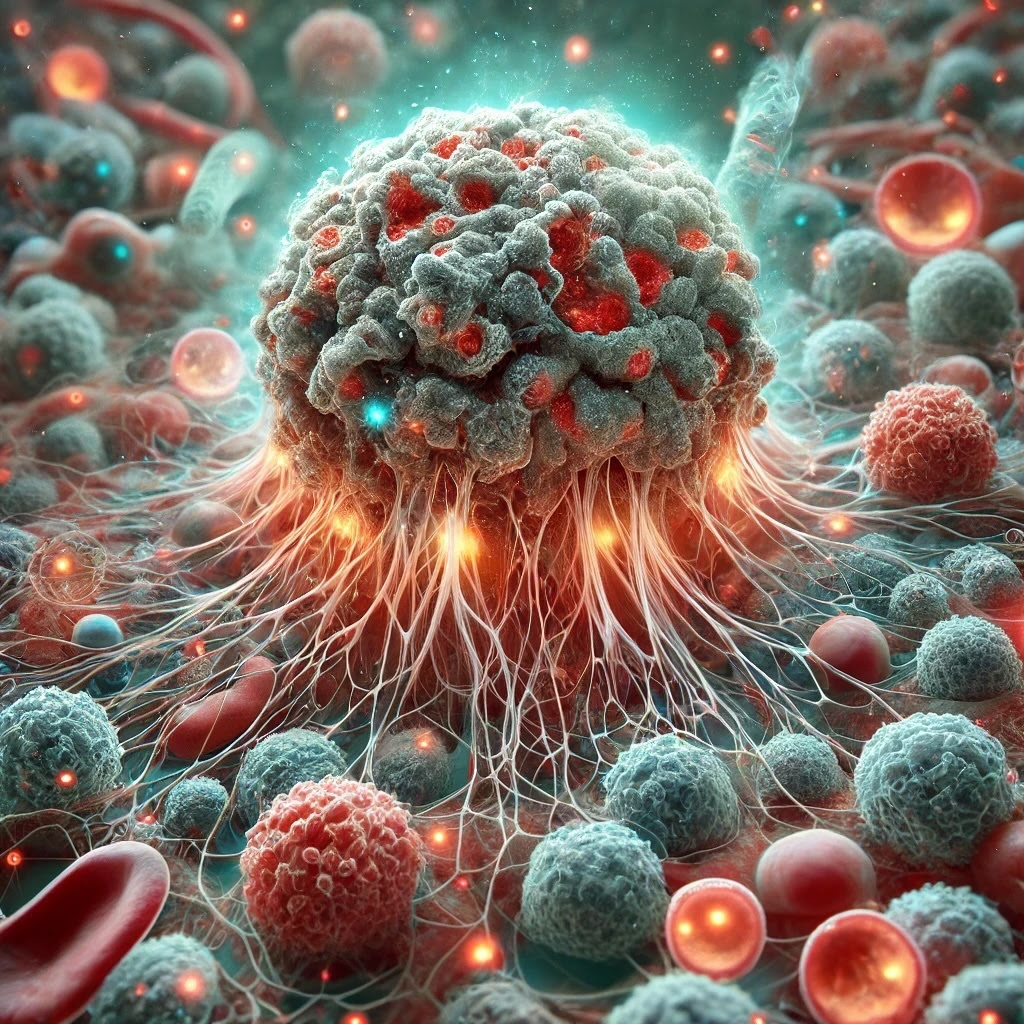
Activation of the MYC gene in prostate cancer leads to major changes in the surrounding microenvironment.
Credit: DALL-E 3/Srinivasan Yegnasubramanian
Scientists have learned that prostate cancers can vary significantly among patients and that there are often differences within each patient’s tumor. However, the study published Aug. 28 in Nature Communications identifies the MYC gene as a common denominator across prostate cancers. The work demonstrates that initial MYC activation attracts immune cells to the tumor but later helps hide the tumor from immune cells. This discovery is the first step toward identifying potential therapeutic targets along the pathway.
“This is a very powerful oncogenic pathway set off by MYC activation,” says Srinivasan Yegnasubramanian, M.D., Ph.D., professor of oncology, pathology, and radiation oncology and molecular radiation sciences, and director of the inHealth precision medicine initiative at Johns Hopkins. “We need to understand this complex cascade of events in detail to find out more effective ways to manage the disease.”Studies of human tumor tissues can help scientists investigate prostate cancer, but they only provide a snapshot. To get a sense of the changes that occur over time in prostate cancer, scientists turn to animal models. Yegnasubramanian and his colleagues married the two approaches to get a detailed look at prostate cancer initiation and progression.
The team used single-cell RNA sequencing to show that targets of the MYC gene are overexpressed in human tumor tissue samples, indicating increased MYC activity. Then, they watched what unfolds in animal models of prostate cancer after MYC activity ramps up.
The researchers found that when MYC initially becomes upregulated in precancerous cells, activity increases in pathways that alert the immune system that something is wrong. But eventually, the immune-attracting pathways are turned off. As the tumor progresses, it stops signaling to the immune system and goes undetected. The discovery may help explain why prostate cancers don’t respond well to immunotherapies that act by removing the brakes on the immune system’s response to cancer — if the immune system is not working to begin with, lifting those brakes will not help.
“These prostate cancer cells have learned how to turn off the signals that would otherwise alert the immune system, allowing them to evade the immune system,” Yegnasubramanian says. “Now, we can try to develop strategies to re-engage the immune response and sensitize the tumors to immunotherapy.”
Drugs targeting TREM2 macrophages — some of the immune cells affected by excess MYC expression in prostate cancer — are already in development and are potential tools to help the immune system fight prostate tumors.
The study, which also used molecular pathology techniques, showed that increased MYC expression and activity starts in epithelial cells lining the prostate. Eventually, the epithelial cells become cancer cells, which signal to surrounding cells, dampening the immune response, causing scarring, expanding the number of tumor cells, and inducing other molecular changes. The study results strengthen the evidence that MYC may be a critical target for prostate cancer treatment or prevention, Yegnasubramanian says.
“We’ve seen some of these changes in human prostate tumors for a long time, but we didn’t understand that the whole process could be set off by one inciting event: upregulation of MYC,” he says.
Mindy Graham and Rulin Wang of Northwestern University were the study’s lead authors; they were at Johns Hopkins at the time the study was conducted. Other researchers involved in the study were Jianyong Liu, Jennifer Meyers, Alyza Skaist, Yan Zhang, Kornel Schuebel, William Nelson, Shawn Lupold, Theodore DeWeese, and Angelo De Marzo of Johns Hopkins. Investigators from the University of Maryland and Baylor College of Medicine also contributed to the study.
The study was supported by the National Institutes of Health, the National Cancer Institute, the Prostate Cancer Foundation, an Allegheny Health Network and Johns Hopkins Pilot Project grant, The Patrick C. Walsh Prostate Cancer Research Fund, the Irving A. Hansen Memorial Foundation, the Commonwealth Foundation and the Maryland Cigarette Restitution Fund Program. The study authors report no conflicts of interest.
Source: Johns Hopkins Medicine. (2024). A Common Culprit Drives Prostate Cancer Progression [Press release]. https://www.hopkinsmedicine.org/kimmel-cancer-center.
Related Content:
Convergent alterations in the tumor microenvironment of MYC-driven human and murine prostate cancer.


